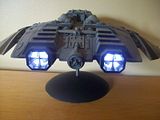You can use the battery you already have, but if the post above by vidman is correct, that 1 amp of current will drain a battery quickly unless it's something big like a lantern battery or cordless tool battery. You might want to get a 12 volt supply of fairly hefty current capability (2 amps or more).
Then all you need to do is put a resistor of the proper value in series with each LED. The LED strips you mentioned as being 12V should have built-in resistors, so no extra resistors needed for those.

Calculate each resistor value in ohms as follows: Rx = (Vsupply - Vled) / I led
where Vled is the LED voltage, and I led is the LED current in AMPS -- LED current is usually given in mA (milliamps), so you need to divide it by 1000 to get amps; 20 mA = 0.020 A
You can save resistors and power by putting a few LEDs in series as indicated by the bottom 2 rungs of my ladder diagram. If you have several LEDs that want the same amount of current, you can put a few of them in series so long as their voltages do not add up to more than the supply. To be safe, you should stay at least a couple of volts below the supply value. For example, you could put 4 green LEDs of 2.1 volts and 25 mA in series. To calculate the resistance, add up the voltages (but not the currents). So the calculation for R3 becomes R3 = (12 - 8.4) / 0.025, or 144 ohms. This is not a standard value for common 5% tolerance resistors, so go up to the next standard value which is 150 ohms.
If you put 2 white LEDs of 3.6 volts and 30 mA in series, the calculation gives R4 = (12 - 7.2) / 0.030, or 160 ohms. This is a standard value but not very common, so you will probably have to go up to 180 ohms.
As was mentioned before, it does not matter if the resistors are on the negative side or the positive side. I drew them on the positive side because that's the conventional way of doing it. Same thing with the switch, it does not matter which side of the battery it goes on.
Also, I think we might need more info about those 6 flickering LEDs for the boosters. They might not want to be wired in series.



